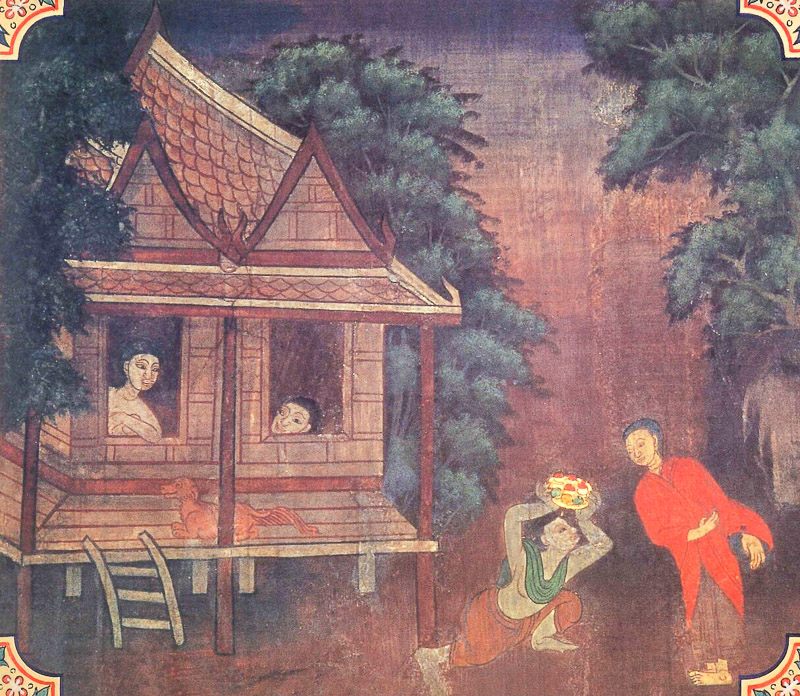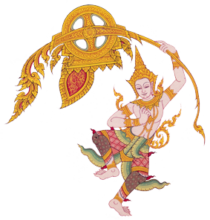
The Bodhisatta was once a royal treasurer. He lived a life of luxury, but faithfully kept the precepts and was extremely generous. One day a private Buddha (those who reach enlightenment on their own and do not teach the path to others) awoke from a seven-day trance and went to the Bodhisatta’s palace for morning alms.
The demon Mara, enemy of all that is good, believed this private Buddha would die if he did not eat that morning. To stop the Bodhisatta from giving him alms, Mara conjured up a deep pit of flaming coal inside the palace. The Bodhisatta knew this must be a ploy of Mara, and he vowed not to let it succeed. He took a bowl of food for the private Buddha and walked right into the fiery pit; as he did so, a large lotus rose up under his feet to protect him. The Bodhisatta placed his offering into the private Buddha’s bowl, then the latter rose into the air and flew away on a track made of clouds. Defeated, Mara vanished into his own realm. The victorious Bodhisatta, still standing on the lotus, preached to those around him about the virtue of giving alms and following the precepts.
In the Lifetime of the Buddha
Anathapindika, a wealthy supporter of the Buddha known for his extreme generosity, had a fairy living over the fourth gateway of his massive palace. The fairy was not a follower of the Buddha and was greatly annoyed that she and her children had to come down to the ground floor to pay respect every time he and his elder disciples visited Anathapindika. She tried unsuccessfully to get Anathapindika’s business manager and his eldest son to stop him hosting these people because of all the money he wasted.
Even after Anathapindika fell into poverty from neglecting his business in order to focus fully on helping people, he continued to give what he could to the Buddha’s sangha. The fairy now saw a chance to change his mind, and she appeared before him in visible form, imploring him to stop donating to the Buddha and instead think of his future and his family. Anathapindika, whose faith in the Buddha never wavered, was so incensed by her words that he kicked her and her children out of the palace.
Now homeless, the fairy asked several gods to convince Anathapindika to let her return. But when they heard the wicked words she had spoken, all refused. Indra, king of the gods, however, did propose a way she could earn his forgiveness. Anathapindika had not sought recovery of many of the loans he had made and had also lost some buried treasure chests. Indra suggested the fairy tell Anathapindika’s delinquent borrowers that while he had not sought payment of debts when he was wealthy, now that he was poor it was time to pay up. And she should take some young goblins with her to scare these people into action. She should also use her supernatural powers to find the missing money.
The fairy did as Indra advised and placed a fortune in his treasury; then she went to seek forgiveness. She explained that she had been stained by passion and blinded by ignorance, but she now recognized the Buddha’s infinite virtue and had sought atonement by recovering his money. Anathapindika welcomed her conversion, but he wanted her to request his pardon in the presence of the Buddha. So the next day they went to his monastery and she confessed what she had done. The Buddha preached that to bad people sin looks good before it ripens, and to virtuous people goodness feels like sin before it ripens. The fairy then fell to the Buddha’s feet in tears to apologize and ask forgiveness, which both the Buddha and Anathapindika granted.
Anathapindika then began to speak highly of himself since the fairy had not swayed him to stop supporting the Buddha. But the Buddha corrected him, explaining that his dedication was no great accomplishment because he was living in the lifetime of a perfect Buddha. As an example of something truly marvelous, the Buddha told Anathapindika this story of one of his own earlier births, when he had taken a huge leap of faith despite there being no perfect Buddha alive to preach truth to the world.
The Buddha did not identify any earlier births other than his own.
